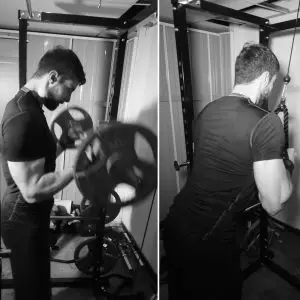Should you train biceps and triceps on the same day? Training biceps and triceps on the same day or during the same session is known as an antagonist workout. Antagonistic training is a proven training method for stimulating muscle growth and therefore it can be a good approach to train biceps and triceps together.
Arms are the favorite body part for a vast majority of people to train when you first get into working out (and a lot later down the training cycle as well), you get a good pump, arms hold less body fat so you see the vascularity when getting a pump and they are a mirror muscle meaning if people see it often then you subconsciously (or consciously) want the muscle to look good.
There are numerous training splits that people follow however besides a dedicated body part split which means you train one muscle group per day it’s often difficult to program a dedicated arm session.
Many people however want to know whether you should actually train biceps and triceps on the same, especially if you are used to following a push/pull split or something familiar. With this in mind I’m dedicating this article to find out whether or not you should train biceps and triceps on the same day.
Should You Train Biceps and Triceps on the Same Day

To get started you’ll first need to understand that training biceps and triceps on the same day means you’ll need to reassess your workout split if you don’t already have a dedicated arm day in your training.
This is because your biceps and triceps are not major muscle groups despite what you might think, they act as secondary muscle for a lot of multi joint compound movements for the upper body. Therefore if you over train them then your key lifts will suffer as a result and it will likely take longer to grow your triceps and biceps!
This is not ideal so you really need to make sure that you aren’t training your arms specifically the day before a heavy push or pull session.
With that side note out of the way it’s now a good time to mention that training arms together is not a new training method, it’s known as antagonistic training which means you train two opposing muscle groups together.
An agonistic and antagonistic muscle grouping works in pairs to stretch, contract and relax a muscle group depending on a movement. As the arms as the example during a bicep curl the tension is on the bicep during the curling motion whilst the tricep relaxes however during the exact movement but performing a tricep press down the tricep is contracted whilst the bicep is relaxed.
This will depend on what muscle group is being loaded during a movement and in general they will be direct opposites, especially for the arms.
When deciding whether you should train biceps and triceps on the same day you will want to look at the pros and cons of each approach.
Pros and Cons of Training Biceps and Triceps Together
As with most things when it comes to building a physique the variables and differing goals between individuals will mean you need to take a customized approach to programming.
I’m therefore just going to highlight the key pros and cons when it comes to training biceps and triceps on the same day.
Pros
- Increased blood flow to the area meaning an increase in muscle cell swelling which is ideal for nutrient uptake
- Reduces stress on the elbow joint because there will be more blood flow in the area meaning the joint will be warmed up sufficiently
- There is research to show strength increases during a training session when training agonistic/antagonistic muscle groups together (Source)
- Reduced muscle fatigue as you switch between muscle groups allowing more rest whilst keeping blood flow in the area
Cons
- As mentioned earlier if you are training any split that is similar to a push/pull then you won’t be able to train arms in the same day
- You risk over training your arms when giving them their own training day followed by training sessions where they will act as a secondary muscle group for heavier sets
- Specialized body part training is only for those in the intermediate to advanced stage of training and physique development. Beginners will see more benefits focusing on either full body, push/pull or upper/lower training splits
Should You Train Biceps and Triceps on Different Days
Now that you are aware of what the pros and cons are when it comes to training biceps and triceps together the next approach that you should look into is training them on different days.
Again this will depend on your training split however it’s likely that you might be training these on different days as it is. If you are a beginner then you should absolutely be training biceps and triceps on different days as an accessory muscle group.
The majority of beginners should be focusing on getting stronger in the multi joint compound movements, working up to a 225lb bench press or 225lb barbell row will do more for your biceps and triceps than a 25lb curl or pressdown.
Even an intermediate level trainer should make sure they have tapped out their potential on the compound movements and at least plateaued on the majority of the compound movements before going down the specialized training routes.
Training Biceps or Triceps First on Arm Day
Training biceps and triceps during the same workout as mentioned is an antagonistic focused workout however this is not to be confused with a superset workout whereby you perform a bicep set followed immediately by a tricep set (the exercise selection is not relevant)
This can of course be a training option however it is an advanced training technique that shouldn’t be used on too many exercises and sets. Therefore you will likely split and arm day routine up with one muscle group trained first in its entirety before moving onto the next.
For arms in particular I would recommend training the biceps first on arm day then followed by your tricep work and my reasoning for this is training longevity.
Tricep training in general places much more stress on the elbow joint and tendons, especially when the joint is not fully warmed up and blood flow is not optimal in the area. A lot of elbow pain that lifters feel originates from heavy pressing and too much strain on the elbow joint.
A key to alleviating this is to train biceps first in your workout and get blood pumping into the upper to warm up the joint and act as cushioning before moving on to the more strenuous exercises of the triceps.
How Often Should You Workout Your Arms
The running them for arm training is that all the factors come down to what your training split is. If you have one dedicated arm day to bring up a weak spot then you should train arms 2 – 3 times per week with this dedicated arm day included.
To do this you would have your dedicated arm day as scheduled however then include a separate bicep and tricep workout to fit in with your other body parts.
The key to this however is to keep volume low on these non specific days and to use it purely as a way to stimulate the muscle and activate protein synthesis.
As an example you might have a pull session on Monday and push session on Wednesday, at the end of each of these workouts you should add a few sets of the related muscle group in relation to the workout.
For the pull session you will add some sets for biceps at the end of this and for the push day a few sets for triceps. Notice that I say sets and not exercises, the reason for this is to keep weekly volume low enough to recover and grow from.
Remember the biceps and triceps are relatively small muscle groups and therefore don’t have the same work capacities as some of the larger muscle groups so you need to make sure you manage weekly volume.
The specific arm day should be the day that you commit to increasing the training volume and working up to the 12 – 18 set range.
How Many Exercises Should You Do for Biceps and Triceps
When deciding how many exercises you should do for biceps and triceps you should really be focusing on one key factor and that should be hitting the desired head of the muscle group with the most optimal movement pattern for this.
I go into more detail about the anatomy of the arms here:
The bicep is made up of two heads (plus a muscle group that runs underneath the bicep as part of the elbow flexor) and the triceps is made up of three heads, hence the names bi and tri.
Therefore in order to optimally target each muscle group you will need to focus on hitting all of the heads. Each has a different function so in order to do this you will need to target each one individually.
Summing that up you should be doing 3 exercises for the biceps and 3 exercises for the triceps in order to maximally recruit the muscle fibres and target all heads of the muscle group.
What Next
If you are looking to make changes to your physique by either losing body fat, building muscle or looking to maintain a lean physique then sign up to my weekly newsletter below. Each week I send out actionable tips to help you lose that extra 1lb of fat or build that extra 0.5lb of muscle mass on a weekly basis.
If you sign up now you’ll also receive my 28 day body recomp program completely Free. This ebook will be sent straight to your inbox and will provide an intense 28 day program aimed at helping you lose up to 8lbs of body fat whilst also building 2lb-4lb of lean muscle mass in just 4 weeks.
Don’t worry if you’re not ready for an intense program just yet, my weekly newsletter will give smaller tips that when implemented daily, will stack up over time and see you transform your body with seemingly minimal effort!
